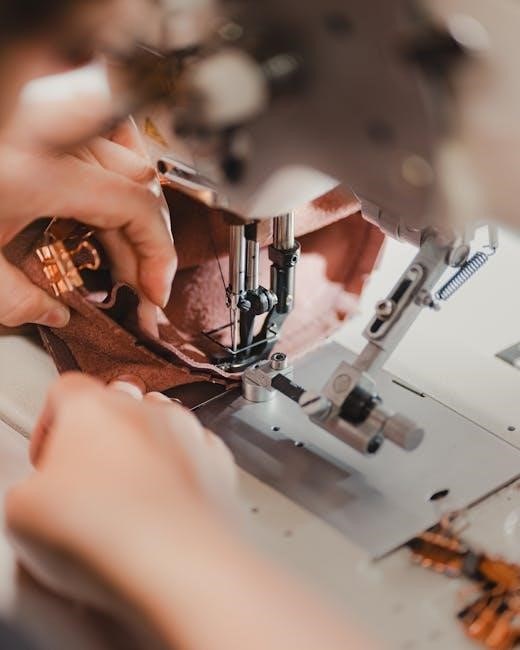InFocus Projector Manual: A Comprehensive Guide
This comprehensive guide offers users easy access to thorough instructions, ensuring high performance․ First-time users & technicians will find assistance․
Accessing InFocus Projector User Manuals
Accessing your InFocus projector user manual is straightforward․ Begin by identifying your projector’s specific model number, often found on a label on the device itself․ Next, visit the official InFocus website and navigate to the “Support” or “Downloads” section․ Here, you can enter your model number to locate and download the corresponding user manual in PDF format․ Alternatively, you can browse through the product series to find your projector․ Many third-party websites also host InFocus projector manuals for free download․ These manuals provide detailed instructions, illustrations, and troubleshooting tips to help you optimize your projector’s performance and resolve any issues you may encounter․ Ensure you download the correct manual for your model to avoid discrepancies in information․ These resources are designed to help both new and experienced users;
Navigating the User Guide
Once you’ve accessed your InFocus projector’s user guide, understanding its structure is key to efficiently finding the information you need․ Typically, the guide begins with a table of contents, providing an overview of the topics covered․ Familiarize yourself with this section to quickly locate specific areas of interest, such as setup instructions, troubleshooting tips, or maintenance procedures․ Pay attention to the use of headings and subheadings, as these help to organize the information logically․ Look for visual aids like diagrams and illustrations, which can clarify complex steps or concepts․ Many user guides also include a glossary of terms, defining technical jargon used throughout the manual․ Use the search function (if available in the digital version) to find specific keywords or phrases related to your query․ Remember to consult the index for a comprehensive list of topics and their corresponding page numbers․ Taking the time to understand the user guide’s layout will save you time and effort in the long run, ensuring you can easily find the answers you need․
Key Features and Functions
Discover the core functionalities of your InFocus projector․ This section details key features for optimal use, security, and performance management․
Understanding Indicator Lights (Lamp, Temp, ON/STAND-BY LEDs)
The indicator lights on your InFocus projector provide crucial information about its operational status․ The Lamp LED indicates the condition of the projector’s lamp․ A steady green light usually signifies normal operation, while a blinking or red light may indicate that the lamp is nearing the end of its life or has a fault․ Refer to the manual for specific blink patterns․ The Temp LED monitors the projector’s internal temperature․ A lit or blinking Temp LED often signals an overheating issue, prompting you to check the ventilation and ensure no obstructions are present․ The ON/STAND-BY LED shows the power state of the projector․ Typically, a solid light indicates the projector is powered on, a blinking light suggests it’s in standby mode, and no light means it’s powered off․ Understanding these indicator lights allows for quick diagnosis of potential problems, ensuring timely maintenance and preventing damage․ Always consult the user manual for detailed interpretations of the LED behavior specific to your InFocus projector model for complete information․
Security Features (Key Lock)
InFocus projectors often incorporate security features to prevent unauthorized use and tampering․ The Key Lock function is a primary security measure that disables the projector’s control panel and/or remote control․ This feature is particularly useful in public settings or classrooms where accidental or malicious button presses could disrupt presentations or alter settings․ When the Key Lock is enabled, users cannot adjust volume, change input sources, or access the menu system directly from the projector or with the remote․ To activate or deactivate the Key Lock, typically you will navigate to the projector’s menu via the on-screen display (OSD) and select the Key Lock option․ The specific steps and password requirements (if any) are detailed in your InFocus projector’s user manual․ Using the Key Lock ensures that only authorized personnel can control the projector, safeguarding settings and preventing unwanted interruptions․ Refer to your projector’s manual for complete instructions, including default passwords and any customizable security settings related to the Key Lock feature․ This helps to maintain a secure and reliable projection environment․

Troubleshooting Common Issues
This section addresses common problems encountered with InFocus projectors․ Find solutions for image display, overheating, and other potential issues․
Image Not Displaying
If your InFocus projector fails to display an image, several factors could be the cause․ First, ensure the projector’s power switch is toggled to the “On” position․ Remove the lens cap if it’s still attached․ Verify that your computer or video device is powered on and sending a signal․ Press the “Source” button on the projector’s keypad or remote to select the correct input source (e․g․, HDMI)․ A common issue is an incorrect input selection; ensure it matches the port your device is connected to․ Check all cable connections between your device and the projector for secure connections․ If using HDMI, try a different HDMI cable to rule out a faulty cable․ If the image still doesn’t appear, consult the user guide for detailed instructions and illustrations specific to your InFocus model․ The user guide provides model-specific steps for troubleshooting display issues․ Ensure that the lamp is functioning correctly; if the lamp LED indicates a problem, lamp replacement might be needed․ If the issue persists after these steps, further diagnostics may be required․ If the projector is receiving power, the LEDs are on, and the input source is correct, consult a technician․
Overheating Prevention
To prevent your InFocus projector from overheating, proper ventilation is crucial․ Ensure that the projector is placed at least 4 feet (1․2 meters) away from any heating or cooling vents․ Never block the ventilation openings on the sides of the projector, as this can lead to overheating and potential damage․ Always turn the projector off and allow it to cool down before moving or storing it․ High temperatures can significantly shorten the lifespan of the projector lamp and other internal components․ If the projector’s temperature LED illuminates, it indicates that the projector is overheating․ In this case, immediately turn off the projector and check for any obstructions blocking the air vents․ Clean the air vents regularly to remove dust and debris that can impede airflow․ When mounting the projector, use only InFocus-approved ceiling mounts to ensure proper ventilation․ Avoid placing the projector in enclosed spaces or areas with poor air circulation․ Operating the projector in high-altitude environments can also increase the risk of overheating; consult the user manual for specific recommendations regarding high-altitude operation․ Following these guidelines will help maintain optimal operating temperatures and prolong the life of your InFocus projector․

Maintenance and Safety
To maintain your InFocus projector and ensure safety, use only genuine lamps․ Proper ventilation is also key to prevent overheating issues․
Lamp Replacement (Genuine Lamps Only)
When it comes to replacing the lamp in your InFocus projector, it is crucial to use only InFocus genuine lamps․ These lamps are specifically tested and designed for optimal performance and safety within your projector model․ Using non-genuine lamps can lead to several issues, including reduced brightness, inconsistent color output, and even potential damage to the projector itself․ Genuine lamps ensure the longevity and reliability of your device․
To replace the lamp, first, power off the projector and allow it to cool down completely․ Refer to your user manual for detailed instructions on accessing the lamp compartment․ Carefully remove the old lamp and insert the new, genuine InFocus lamp․ Ensure it is securely in place before closing the compartment․ Proper installation is vital to prevent any operational problems․ Always dispose of the old lamp responsibly, following local regulations for electronic waste disposal․ Remember, investing in a genuine InFocus lamp is an investment in the continued performance and safety of your projector, guaranteeing the best possible viewing experience for years to come․
Ventilation Requirements
Proper ventilation is paramount to the lifespan and performance of your InFocus projector․ Overheating can cause significant damage to internal components, leading to reduced image quality, operational instability, and ultimately, premature failure․ To ensure adequate ventilation, it’s crucial to avoid blocking any of the projector’s air vents․ These vents are strategically placed to allow for efficient airflow, dissipating heat generated during operation․
When setting up your projector, make sure to position it in a location that allows for unobstructed airflow around all sides․ Avoid placing the projector in enclosed spaces, such as cabinets or tight shelves, unless they are specifically designed for projector use and provide sufficient ventilation․ Ensure there is ample space between the projector and any nearby objects, such as walls or furniture, to prevent airflow restriction․ Regularly check the vents for dust accumulation and clean them as needed, using a soft brush or vacuum cleaner․ By adhering to these ventilation requirements, you can maintain optimal operating temperatures and prolong the life of your InFocus projector, ensuring consistently high-quality performance for your presentations and entertainment․

Connecting External Devices
Connecting external devices is simple․ Ensure proper connections and source selection for optimal display․ Refer to the manual for detailed steps․
Selecting the Correct Input Source (HDMI)
Selecting the correct input source, particularly HDMI, is crucial for displaying content from external devices on your InFocus projector․ First, physically connect your device (laptop, Blu-ray player, etc․) to the projector’s HDMI port using an HDMI cable․ Once the connection is established, power on both the projector and the external device․ Next, navigate to the projector’s menu system․ This can typically be done using the buttons on the projector itself or via the remote control․ Look for an option labeled “Source,” “Input,” or something similar․ Select this option, and a list of available input sources should appear․ Choose “HDMI” from the list․ The exact wording may vary slightly depending on your specific InFocus projector model, but it will generally be clear․ After selecting the HDMI input, the projector should automatically detect the signal from your connected device and display its screen․ If the image does not appear immediately, ensure that the HDMI cable is securely plugged into both the projector and the external device․ Also, verify that the external device is outputting a signal and that the correct display settings are configured on that device․ For instance, make sure the laptop is not set to display only on its internal screen․ Consult the user guide for detailed instructions․

Placement and Setup
Proper placement ensures optimal image quality and projector longevity․ Consider horizontal positioning, tilt angle, and proximity to vents for best results․
Horizontal Positioning and Tilt Angle
Achieving the ideal image requires careful attention to horizontal positioning and tilt angle․ Ensure the projector sits on a stable, level surface․ The InFocus projector’s tilt angle should not exceed 15 degrees to prevent image distortion․ For optimal horizontal positioning, place the projector perpendicular to the screen’s center․ This minimizes keystone effect, where the image appears trapezoidal․ If keystone correction is necessary, use the projector’s built-in keystone adjustment features, but avoid excessive correction as it can degrade image quality․ Consider using a spirit level to verify the projector’s horizontal alignment․ For ceiling-mounted projectors, use InFocus-approved mounts to guarantee stability and safety․ Double-check all mounting hardware for secure attachment․ Fine-tune the horizontal and vertical adjustments after mounting to achieve a perfectly rectangular image․ Always consult the user manual for your specific InFocus model for detailed instructions and recommended settings․ Remember, accurate horizontal positioning and a minimal tilt angle are crucial for a clear and geometrically correct projected image, enhancing your viewing experience․
Distance from Heating and Cooling Vents
Maintaining an appropriate distance from heating and cooling vents is crucial for the longevity and optimal performance of your InFocus projector․ Locate the projector at least 4 feet (1․2 meters) away from any heating or cooling vents․ Direct exposure to hot or cold air can cause internal components to overheat or experience rapid temperature fluctuations, potentially leading to premature failure of the lamp, image sensor, or other sensitive electronics․ Restricted airflow can also trigger the projector’s overheating protection mechanisms, causing it to shut down unexpectedly․ Ensure that the projector’s ventilation openings are never blocked by furniture, curtains, or other objects․ Proper ventilation is essential for dissipating heat generated during operation․ Regularly inspect the vents for dust accumulation and clean them with a soft brush or vacuum cleaner to maintain efficient airflow․ If using the projector in a confined space, consider additional ventilation measures, such as a fan, to prevent heat buildup․ Refer to the user manual for your specific InFocus model for recommended operating temperatures and humidity levels․ Adhering to these guidelines will help to prevent damage, ensure consistent performance, and extend the lifespan of your InFocus projector․
